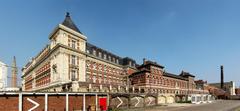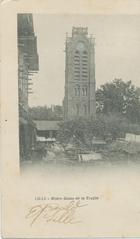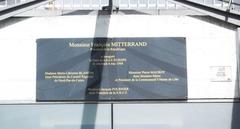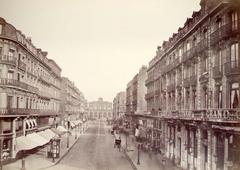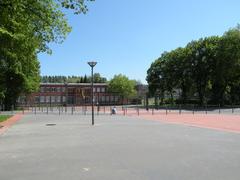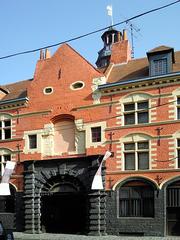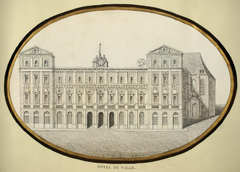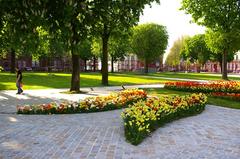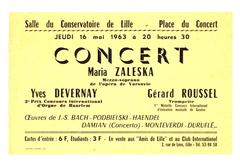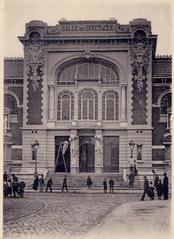Musée d’Histoire Naturelle de Lille: Hours, Tickets & Complete Visitor Guide
Date: 14/06/2025
Introduction
Nestled in the heart of Lille, the Musée d’Histoire Naturelle de Lille stands as one of France’s oldest and most esteemed natural history museums. With origins dating back to 1802, the museum has evolved into a vibrant center of scientific discovery, cultural education, and community engagement. Home to over 450,000 objects spanning zoology, geology, ethnography, and the sciences, it offers visitors a fascinating journey through the natural world and human history. As the museum undergoes a transformative renovation, this guide provides everything you need to plan your visit—whether in person after reopening or virtually today.
Table of Contents
- Introduction
- Historical Overview and Significance
- Permanent Collections
- Temporary Exhibitions & “Le Musée fait le Mur”
- Visiting Hours and Ticket Information
- Accessibility and Visitor Services
- Travel Tips & Nearby Attractions
- Renovation and Expansion Project (2020–2026)
- Visitor Experience & Educational Impact
- Digital and Virtual Offerings
- FAQs
- Conclusion & Call to Action
- References
Historical Overview and Significance
Origins and Early Growth (1802–1902)
The museum’s roots trace to the Société des Amateurs des Sciences et des Arts, established in 1802. Early collections included exotic animals, insects, and minerals, reflecting a burgeoning interest in science and public education (mhn.lille.fr; fr.wikipedia.org). By 1822, it was officially inaugurated, making it one of the earliest provincial natural history museums in France.
The museum quickly became an academic hub, with close ties to the University of Lille. Its curators—often university professors—ensured the collections served both public and scientific communities (mhn.lille.fr). The addition of a geology and mineralogy department in 1877, led by Jules Gosselet, further diversified its scope (proscitec.asso.fr).
Architectural and Urban Significance
In 1902, the museum moved to its current site at 23 rue Gosselet, in Lille’s historic university district. The neo-classical building, with its Baltard-style ironwork, symbolizes the city’s dedication to science and progress (archdaily.com). Its integration into the urban fabric and proximity to other cultural institutions underscore Lille’s commitment to heritage and innovation (lille.fr).
Educational and Cultural Impact
From the outset, the museum prioritized public education, offering exhibitions, workshops, and collaborations with schools and universities. Its collections have sparked reflection on biodiversity, colonial history, and scientific advancement, positioning the museum as a leader in both research and community outreach (fr.wikipedia.org; proscitec.asso.fr).
Permanent Collections
Overview
Today, the museum’s holdings rank among the most significant in France, with over 450,000 objects in four principal domains:
- Zoology: The flagship collection, featuring rare mammals, birds, reptiles, insects, and several extinct species. Highlights include suspended whale skeletons and intricate dioramas (59.agendaculturel.fr).
- Geology and Paleontology: Spanning 400 million years, with minerals, rocks, fossils, and life-size prehistoric reconstructions (lille.fr).
- Ethnography: A rich collection of artifacts reflecting diverse global cultures and humanity’s relationship with nature (fr.wikipedia.org).
- Sciences and Techniques: Instruments and archives illustrating Lille’s industrial and scientific heritage (en.wikipedia.org).
Interactive panels, digital resources, and family-friendly displays foster a dynamic and inclusive learning environment (mhn.lille.fr).
Temporary Exhibitions & “Le Musée fait le Mur”
Thematic Exhibitions
The museum regularly curates one or two major thematic exhibitions annually, touching on topics such as climate change, extinction, and the latest scientific discoveries. These feature rare specimens, interactive installations, and multimedia presentations (mhn.lille.fr).
Outreach During Renovation
Currently closed for renovation, the museum remains active through “Le Musée fait le Mur”—off-site exhibitions in local venues, virtual tours, and educational programming in schools and community centers (mhn.lille.fr).
Visiting Hours and Ticket Information
Standard Visiting Hours
- Monday: Closed
- Tuesday–Sunday: 10:00 am – 6:00 pm (last admission 30 minutes before closing)
- Note: The museum is closed for renovations until late 2026/early 2027. Virtual tours and outreach events continue online.
Ticket Prices
- Adults: €8 (subject to change post-renovation)
- Reduced: €5 (students, seniors)
- Children under 18: Free
- Family and group rates: Available
- Free Sundays: For Lille, Hellemmes, and Lomme residents with proof of address (lille.fr)
Tickets are available online via the official museum website.
Accessibility and Visitor Services
- Wheelchair accessible: Ramps, lifts, and accessible restrooms are available.
- Multilingual resources: Panels and guides in French and English; digital content accessible via QR codes.
- Support for special needs: Please contact in advance for assistance.
Travel Tips & Nearby Attractions
Getting There
- Address: 23 rue Gosselet, 59000 Lille (mhn.lille.fr)
- Public transport: Lille Metro lines 1 & 2 (Gare Lille Flandres or Rihour stations), bus lines, and bike lanes.
- By train: Lille is served by TGV (Paris, Brussels, London).
Nearby Sights
- Palais des Beaux-Arts de Lille: Major fine arts museum.
- Grand Place: Central square with shopping and dining.
- Old Lille: Picturesque historic district with boutiques and cafes.
Renovation and Expansion Project (2020–2026)
Timeline & Scope
- Phase 1 (2021): New entrance, expanded reception, and improved accessibility (mhn.lille.fr).
- Phase 2 (2024–2026/7): Led by Snøhetta, adding 70% more exhibition space, new educational facilities, and sustainable design (snohetta.com).
Key Features
- Expanded public spaces and exhibition capacity.
- Innovative education zones including a 700 m² experimental forum and a “nest” for young children.
- Sustainability: Green materials, energy efficiency, and biodiversity-promoting gardens.
- Universal accessibility and improved visitor flow.
During closure, the museum offers virtual tours and citywide educational events (lille.fr; lejournaldesarts.fr).
Visitor Experience & Educational Impact
Atmosphere and Highlights
The museum’s immersive displays—from marine mammal skeletons to regional biodiversity exhibits—offer a sense of wonder and discovery. Interactive zones, tactile displays, and digital guides make the experience accessible and engaging for all ages (visite-lille.com).
Educational Programs
- Workshops and school visits: Aligned with the French curriculum, focusing on biodiversity, geology, and conservation.
- Public lectures and events: Including Earth Day and European Night of Museums.
- Family activities: Scavenger hunts, digital guides, and hands-on workshops (mhn.lille.fr).
Digital and Virtual Offerings
As part of its commitment to accessibility and innovation, the museum has enhanced its digital presence. Explore virtual tours, downloadable guides, and participate in interactive online content during the renovation (mhn.lille.fr).
Frequently Asked Questions (FAQ)
Q: When will the museum reopen?
A: Scheduled for late 2026 or early 2027 after renovations.
Q: Are virtual tours available?
A: Yes, free digital resources and virtual tours are available on the museum’s website.
Q: Is the museum accessible to those with reduced mobility?
A: Yes, with ramps, lifts, and adapted restrooms.
Q: How do I get tickets?
A: When open, tickets are available on-site and online. Check mhn.lille.fr for updates.
Q: Are there family and school programs?
A: Yes, with tailored workshops, guides, and activities.
Q: Where is the museum located?
A: 23 rue Gosselet, Lille, near major metro and bus lines.
Conclusion & Call to Action
The Musée d’Histoire Naturelle de Lille remains a cornerstone of science, culture, and education in northern France. While temporarily closed for a landmark renovation, its collections and programs remain accessible through digital offerings and community outreach. Plan your future visit, explore online content, and discover Lille’s rich scientific heritage.
Stay informed:
- Subscribe to the museum’s newsletter
- Follow official social media channels
- Download the Audiala app for exclusive content, updates, and virtual tours
Experience the wonders of natural history—whether virtually today or in person soon.
References
- Historical Overview and Significance of the Musée d’Histoire Naturelle de Lille, 2025, MHN Lille (mhn.lille.fr)
- Musée d’Histoire Naturelle de Lille Renovation and Expansion Project, 2024, Lille.fr (lille.fr)
- Renovation Details by Snøhetta, 2024, Snøhetta Official Website (snohetta.com)
- Exploring the Musée d’Histoire Naturelle de Lille: Visiting Hours, Tickets, and Highlights, 2024, Agendaculturel (59.agendaculturel.fr)
- Visiting Musée d’Histoire Naturelle de Lille: Hours, Tickets & Visitor Guide, 2024, Visite Lille (visite-lille.com)
- Musée d’Histoire Naturelle de Lille Wikipedia Entry, 2024 (fr.wikipedia.org)
- Musée d’Histoire Naturelle de Lille Renovation Coverage, 2024, Le Journal des Arts (lejournaldesarts.fr)
